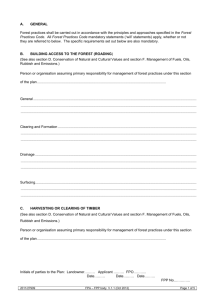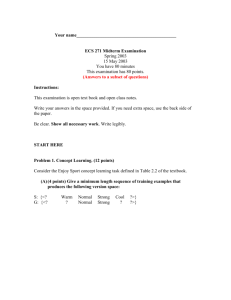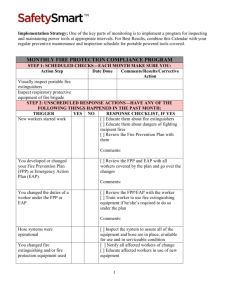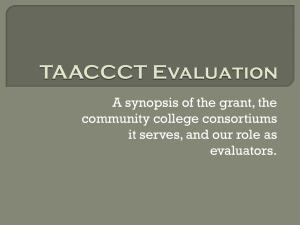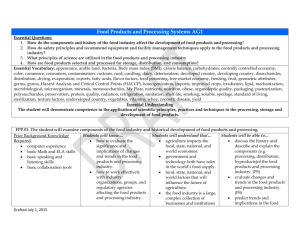Food Products & Processing Systems
advertisement
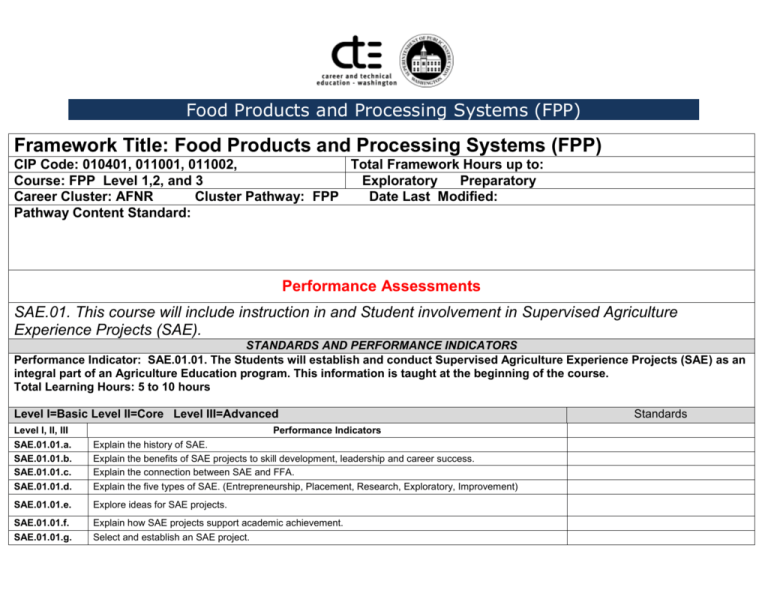
Food Products and Processing Systems (FPP) Framework Title: Food Products and Processing Systems (FPP) CIP Code: 010401, 011001, 011002, Total Framework Hours up to: Course: FPP Level 1,2, and 3 Exploratory Preparatory Career Cluster: AFNR Cluster Pathway: FPP Date Last Modified: Pathway Content Standard: Performance Assessments SAE.01. This course will include instruction in and Student involvement in Supervised Agriculture Experience Projects (SAE). STANDARDS AND PERFORMANCE INDICATORS Performance Indicator: SAE.01.01. The Students will establish and conduct Supervised Agriculture Experience Projects (SAE) as an integral part of an Agriculture Education program. This information is taught at the beginning of the course. Total Learning Hours: 5 to 10 hours Level I=Basic Level II=Core Level III=Advanced Level I, II, III Performance Indicators SAE.01.01.a. SAE.01.01.b. SAE.01.01.c. SAE.01.01.d. Explain the history of SAE. Explain the benefits of SAE projects to skill development, leadership and career success. Explain the connection between SAE and FFA. Explain the five types of SAE. (Entrepreneurship, Placement, Research, Exploratory, Improvement) SAE.01.01.e. Explore ideas for SAE projects. SAE.01.01.f. SAE.01.01.g. Explain how SAE projects support academic achievement. Select and establish an SAE project. Standards SAE.01.01.h. SAE.01.01.i. Explain and keep records on established SAE projects. Explain SAE project Supervision, visitation and assessment. SAE.01.01.j. SAE.01.01.k. SAE.01.01.l. Explain how SAE projects benefit the community. Seek recognition for SAE project accomplishments. Explain the three circle concept for SAE, FFA Leadership, and Classroom/Laboratory in an Agriculture Education program. Performance Element Assessed: FPP.01. Performance Element: Examine components of the food industry and historical development of food products and processing. PERFORMANCE INDICATOR(S) FPP.01.01. Performance Indicator: Evaluate the significance and implications of changes and trends in the food products and processing industry. Sc F1, LA 7 and 8, and SS 1G and 8C FPP.01.02. Performance Indicator: Work effectively with industry organizations, groups and regulatory agencies affecting the food products and processing industry. LA 12, and SS 6C and 8F Number Performance: Level I=Basic Level II=Core Level III=Advanced FPP.01.01.01.a. FPP.01.01.01.b. FPP.01.01.01.c. FPP.01.01.02.a. FPP.01.01.02.b. FPP.01.01.02.c. FPP.01.02.01.a. FPP.01.02.01.b. FPP.01.02.01.c. FPP.01.02.02.a. FPP.01.02.02.b. FPP.01.02.02.c. Discuss the history and describe and explain the components (e.g., processing, distribution, byproducts) of the food products and processing industry. Level I Evaluate changes and trends in the food products and processing industry. Level II Predict trends and implications in the food products and processing industry. Level III Identify and explain environmental and safety concerns about the food supply. Level I Discuss the issues of safety and environmental concerns about foods and food processing (e.g., Genetically Modified Organisms, microorganisms, contamination, irradiation). Level II Determine appropriate industry response to consumer concerns to assure a safe and wholesome food supply. Level III Explain the purposes of organizations that are part of or regulate the food products and processing industry. Level I Evaluate the changes in the food products and processing industry brought about by industry organizations or regulatory agencies. Level II Interact effectively with organizations, groups and regulatory agencies that affect the food products and processing industry. Level III Explain the importance and usage of industry standards in food products and processing. Level I Discuss the application of industry standards in the food products and processing industry. Level II Prepare a plan for implementation of industry standards in food products and processing programs. Level III Social Studies - Civics Writing Page 2 of 10 Standard # Art Science Standards Mathematics Standards SKILLS Leadership: Employability: Analytical, Logical & Creative Thinking (check those that students will demonstrate in this lesson): Observe Cause/Effect Finding Evidence Reasoning Patterns Fact/Opinion Evaluation Problem Solving Sequence Main Idea Detect Bias Goal Setting Classify Summary Inference Fluency Compare/Contrast Point of View Conclusion Elaboration Predict Analysis Metacognition Flexibility Relevance to Work: Understanding that a strong work ethic will contribute to higher productivity in organizations. Originality Risking Inquisitiveness Attending Persistence Precision Performance Element Assessed: FPP.02. Performance Element: Apply safety principles, recommended equipment and facility management techniques to the food products and processing industry. PERFORMANCE INDICATOR(S) FPP.02.01. Performance Indicator: Manage operational procedures and create equipment and facility maintenance plans. LA 12 FPP.02.02. Performance Indicator: Implement Hazard Analysis and Critical Control Point (HACCP) procedures to establish operating parameters. Sc F5, LA 8 FPP.02.03. Performance Indicator: Apply safety and sanitation procedures in the handling, processing and storing of food products. Sc A2 and F5 FPP.02.04. Performance Indicator: Demonstrate worker safety procedures with food product and processing equipment and facilities. Sc F5, LA 8 Number Performance: Level I=Basic Level II=Core Level III=Advanced FPP.02.01.01.a. FPP.02.01.01.b. FPP.02.01.01.c. FPP.02.01.02.a. Explain the importance of developing and maintaining Sanitation Standard Operating Procedures (SSOP). Level I Evaluate the SSOP of a food products and processing company. Level II Develop SSOP for a food products and processing company. Level III Explain the purpose of Good Manufacturing Practices (GMP). Level I Page 3 of 10 Standard # FPP.02.01.02.b. FPP.02.01.02.c. Evaluate the GMP of a food products and processing company. Level II Implement GMP for a food products and processing company. Level III FPP.02.01.03.a. FPP.02.01.03.b. FPP.02.01.03.c. Identify reasons for using a planned maintenance program to maintain equipment and facilities. Level I Develop a basic equipment and facility maintenance program. Level II Perform basic equipment and facility maintenance in a food products and processing operation. Level III Describe contamination hazards (physical, chemical and biological) associated with food products and processing. Level I Outline procedures to eliminate possible contamination hazards associated with food products and processing. Level II Analyze the effectiveness of a food products and processing company’s Critical Control Point (CCP) procedures. Level III Identify the seven principles of HACCP. Level I Explain the implementation of the seven principles of HACCP. Level II Implement an HACCP program for a food products and processing facility. Level III Explain techniques and procedures for the safe handling of food products. Level I Evaluate food product handling procedures. Level II Demonstrate approved food product handling techniques. Level III FPP.02.02.01.a. FPP.02.02.01.b. FPP.02.02.01.c. FPP.02.02.02.a. FPP.02.02.02.b. FPP.02.02.02.c. FPP.02.03.01.a. FPP.02.03.01.b. FPP.02.03.01.c. FPP.02.03.02.a. FPP.02.03.02.b. FPP.02.03.02.c. FPP.02.03.03.a. FPP.02.03.03.b. FPP.02.03.03.c. FPP.02.03.04.a. FPP.02.03.04.b. FPP.02.03.04.c. FPP.02.04.01.a. FPP.02.04.01.b. FPP.02.04.01.c. Describe the importance of performing quality-assurance tests on food products. Level I Perform quality-assurance tests on food products. Level II Interpret quality-assurance test results and apply corrective procedures. Level III Describe the effects food-borne pathogens have on food products and humans. Level I Explain the importance of microbiological tests in food product preparation, listing common spoilage and pathogenic microorganisms. Level II Conduct and interpret microbiological tests for food-borne pathogens and implement corrective procedures. Level III Explain the importance of record keeping in a food product and processing system. Level I Discuss documentation procedures in a food products and processing system. Level II Demonstrate proper record keeping in a food products and processing system. Level III Explain safety standards that must be observed in facility design and equipment use. Level I Outline guidelines for personnel safety in the food products and processing industry. Level II Evaluate a facility to determine the implementation of safety procedures. Level III Social Studies - Civics Writing Art Science Standards Page 4 of 10 Mathematics Standards SKILLS Leadership: Employability: Analytical, Logical & Creative Thinking (check those that students will demonstrate in this lesson): Observe Cause/Effect Finding Evidence Reasoning Patterns Fact/Opinion Evaluation Problem Solving Sequence Main Idea Detect Bias Goal Setting Classify Summary Inference Fluency Compare/Contrast Point of View Conclusion Elaboration Predict Analysis Metacognition Flexibility Relevance to Work: Understanding that a strong work ethic will contribute to higher productivity in organizations. Originality Risking Inquisitiveness Attending Persistence Precision Performance Element Assessed: FPP.03. Performance Element: Apply principles of science to the food products and processing industry. PERFORMANCE INDICATOR(S) FPP.03.01. Performance Indicator: Apply principles of science to food processing to provide a safe, wholesome and nutritious food supply. Sc A2, B3, and F1 Number Performance: Level I=Basic Level II=Core Level III=Advanced FPP.03.01.01.a. FPP.03.01.01.b. FPP.03.01.01.c. FPP.03.01.02.a. FPP.03.01.02.b. FPP.03.01.02.c. FPP.03.01.03.a. FPP.03.01.03.b. FPP.03.01.03.c. FPP.03.01.04.a. Discuss how research and industry developments lead to improvements in the food products and processing industry. Level I Design a research project in food science using the scientific method. Level II Conduct research in food science and interpret results to improve food products. Level III Explain the application of chemistry and physics to food science. Level I Explain how the chemical and physical properties of foods influence nutritional value and eating quality. Level II Determine the chemical and physical properties of food products. Level III Explain the Food Guide Pyramid in relation to essential nutrients for the human diet. Level I Compare and contrast the nutritive value of food and food groups. Level II Design a daily food guide for a healthful diet. Level III Discuss common food constituents (e.g., proteins, carbohydrates, fats, vitamins, minerals). Level I Page 5 of 10 Standard # FPP.03.01.04.b. FPP.03.01.04.c. Compare and contrast food constituents and their relative value to product taste, appearance, etc. Level II Analyze food products to identify food constituents. Level III FPP.03.01.05.a. FPP.03.01.05.b. FPP.03.01.05.c. FPP.03.01.06.a. FPP.03.01.06.b. FPP.03.01.06.c. Identify common food additives (e.g., preservatives, antioxidants, buffers, stabilizers, colors, flavors). Level I Describe the purpose of common food additives. Level II Formulate and explain incorporation of additives into food products. Level III Explain the importance of food labeling to the consumer. Level I Explain the required components of a food label. Level II Prepare and label foods according to the established standards of regulatory agencies. Level III Describe factors in planning and developing a new food product (e.g., regulation, creativity, and economics). Level I Plan and create a new food product. Level II Perform sensory-testing and marketing functions to characterize and determine consumer preference and market potential. Level III Social Studies - Civics FPP.03.01.07.a. FPP.03.01.07.b. FPP.03.01.07.c. Writing Art Science Standards Mathematics Standards SKILLS Leadership: Employability: Analytical, Logical & Creative Thinking (check those that students will demonstrate in this lesson): Observe Cause/Effect Finding Evidence Reasoning Patterns Fact/Opinion Evaluation Problem Solving Sequence Main Idea Detect Bias Goal Setting Classify Summary Inference Fluency Compare/Contrast Point of View Conclusion Elaboration Predict Analysis Metacognition Flexibility Relevance to Work: Understanding that a strong work ethic will contribute to higher productivity in organizations. Performance Element Assessed: Page 6 of 10 Originality Risking Inquisitiveness Attending Persistence Precision FPP.04. Performance Element: Select and process food products for storage, distribution and consumption. PERFORMANCE INDICATOR(S) FPP.04.01. Performance Indicator: Utilize harvesting, selection and inspection techniques to obtain quality food products for processing. Sc F1 and LA 12 FPP.04.02. Performance Indicator: Evaluate, grade and classify processed food products. Sc F1 and LA 8 FPP.04.03. Performance Indicator: Process, preserve, package and present food and food products for sale and distribution. M 1C, 4A, and 4B, Sc F1 Number Performance: Level I=Basic Level II=Core Level III=Advanced FPP.04.01.01.a. FPP.04.01.01.b. FPP.04.01.01.c. FPP.04.01.02.a. Identify quality and yield grades of food products. Level I Discuss factors that affect quality and yield grades of food products. Level II Assign quality and yield grades to food products according to industry standards. Level III Select raw food products based on yield grades, quality grades and related selection criteria. Level I FPP.04.01.02.b. Perform quality-control inspections of raw food products for processing. Level II FPP.04.01.02.c. FPP.04.01.03.a. FPP.04.01.03.b. FPP.04.01.03.c. FPP.04.01.04.a. FPP.04.01.04.c. FPP.04.02.01.a. Implement procedures to maintain original food quality and yield. Level III Identify and describe accepted animal treatment and harvesting techniques. Level I Compare and contrast accepted animal treatment and harvesting techniques. Level II Harvest animals using regulatory-agency- approved or industry-approved techniques. Level III Describe the importance of pre-mortem and post-mortem inspections of animals for harvest. Level I Explain desirable and undesirable characteristics of both pre-mortem and post-mortem animals in relation to the production of food products. Level II Conduct pre-mortem and postmortem inspections of animals. Level III Identify and describe foods derived from meat, egg, poultry, fish and dairy products. Level I FPP.04.02.01.b. FPP.04.02.01.c. FPP.04.02.02.a. FPP.04.02.02.b. FPP.04.02.02.c. FPP.04.02.03.a. Discuss desirable qualities of processed meat, egg, poultry, fish and dairy products. Level II Evaluate, grade and classify processed meat, egg, poultry, fish and dairy products. Level III Identify and describe products derived from fruits and vegetables. Level I Discuss desirable qualities of fruit and vegetable products. Level II Evaluate, grade and classify processed products from fruits and vegetables. Level III Identify and describe products derived from grains, legumes and oilseeds. Level I FPP.04.02.03.b. FPP.04.02.03.c. Discuss desirable qualities of grain, legume and oilseed products. Level II Evaluate, grade and classify finished products derived from grains, legumes and oilseeds. Level III Identify and explain common weights and measures used in the food products and processing industry. Level I Weigh and measure food products and perform conversions between units of measure. Level II Use weights and measures to formulate and package food products. Level III Explain methods and materials for processing foods for sale as fresh-food products. Level I FPP.04.01.04.b. FPP.04.03.01.a. FPP.04.03.01.b. FPP.04.03.01.c. FPP.04.03.02.a. Page 7 of 10 Standard # FPP.04.03.02.b. FPP.04.03.02.c. FPP.04.03.03.a. FPP.04.03.03.b. FPP.04.03.03.c. FPP.04.03.04.a. FPP.04.03.04.b. FPP.04.03.04.c. FPP.04.03.05.a. FPP.04.03.05.b. FPP.04.03.05.c. FPP.04.03.06.a. FPP.04.03.06.b. FPP.04.03.06.c. Prepare foods for sale and distribution as fresh-food products. Level II Evaluate foods prepared for the fresh food market based on factors such as shelf life, shrinkage, appearance and weight. Level III Identify methods of food preservation and give examples of foods preserved by each method. Level I Explain the processes of food preservation methods. Level II Preserve foods using various methods and techniques. Level III Explain techniques for preparing ready-to-eat food products. Level I Demonstrate techniques of preparing ready-to-eat food products. Level II Evaluate ready-to-eat food products. Level III Explain materials and methods of food packaging and presentation. Level I Select and utilize packaging materials in storing processed foods and raw food products. Level II Analyze the foods stored in various packaging materials to determine which materials retain desirable food qualities. Level III Identify and explain storage conditions to preserve product quality. Level I Select methods and conditions for storing raw and processed food products. Level II Compare and contrast foods stored under varying conditions for quality, shelf life and intended use. Level III Social Studies - Civics Writing Art Science Standards Mathematics Standards SKILLS Leadership: Employability: Analytical, Logical & Creative Thinking (check those that students will demonstrate in this lesson): Observe Cause/Effect Finding Evidence Reasoning Patterns Fact/Opinion Evaluation Problem Solving Sequence Main Idea Detect Bias Goal Setting Classify Summary Inference Fluency Compare/Contrast Point of View Conclusion Elaboration Predict Analysis Metacognition Flexibility Relevance to Work: Understanding that a strong work ethic will contribute to higher productivity in organizations. Page 8 of 10 Originality Risking Inquisitiveness Attending Persistence Precision Performance Assessments To be completed by district Performance Indicator: STANDARDS AND PERFORMANCE INDICATORS Total Learning Hours for Standard: Level II=Core Level III=Advanced Level II Performance Indicator Description Level III EALRs, GLEs, Math and Science Standards (Taught & Assessed in Standards) (Samples included below of GLEs, EALRS, Math and Science Standards must be modified for district frameworks) Reading Communications Social Studies - Civics Writing Page 9 of 10 Art Science Standards Mathematics Standards SKILLS Leadership: Employability: Analytical, Logical & Creative Thinking (check those that students will demonstrate in this lesson): Observe Cause/Effect Finding Evidence Reasoning Patterns Fact/Opinion Evaluation Problem Solving Sequence Main Idea Detect Bias Goal Setting Classify Summary Inference Fluency Compare/Contrast Point of View Conclusion Elaboration Predict Analysis Metacognition Flexibility Relevance to Work: Understanding that a strong work ethic will contribute to higher productivity in organizations. Page 10 of 10 Originality Risking Inquisitiveness Attending Persistence Precision

